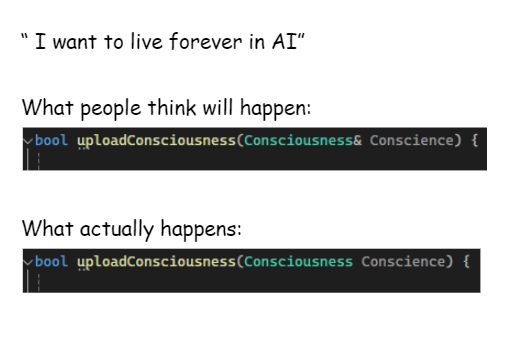this post was submitted on 25 Apr 2024
720 points (95.6% liked)
Programmer Humor
19606 readers
676 users here now
Welcome to Programmer Humor!
This is a place where you can post jokes, memes, humor, etc. related to programming!
For sharing awful code theres also Programming Horror.
Rules
- Keep content in english
- No advertisements
- Posts must be related to programming or programmer topics
founded 1 year ago
MODERATORS
you are viewing a single comment's thread
view the rest of the comments
view the rest of the comments

Thanks fellow traveller for punching holes in computational stupidity. Everything you said is true but I also want to point out that the brain is an analog system so the information in a neuron is infinite relative to a digital system (cf: digitizing analog recordings). As I tell my students if you are looking for a binary event to start modeling, look to individual ions moving across the membrane.
So it's not infinite and can be digitized. :)
But to be more serious, digitized analog recordings is a bad analogy because audio can be digitized and perfectly reproduced. Nyquist- Shannon theory means the output can be perfectly reproduced. It's not approximate. It's perfect.
https://en.m.wikipedia.org/wiki/Nyquist%E2%80%93Shannon_sampling_theorem
It's an analogy. There is actually an academic joke about the point you are making.
The point of the analogy is not that one can't get close enough so that the ear can't detect a difference, it's that in theory analog carries infinite information. It's true that vinyl recordings are not perfect analog systems because of physical limitations in the cutting process. It's also true for magnetic tape etc. But don't mistake the metaphor for the idea.
Ionic movement across membranes, especially at the scale we are talking about, and the density of channels in the system is much closer to an ideal system. How much of that fidelity can you lose before it's not your consciousness?
"I'd like to talk to her, but first I have to cover half the distance between where we are and where she is, then half of the distance that remains, then half of that distance, and so on. The series is infinite. "
I get it's a joke but that's a bad joke. That's a convergent series. It's not infinite. Any 1st year calculus student would know that.
"it's that in theory analog carries infinite information. "
But in reality it can't. The universe isn't continous, it's discrete. That's why we have quantum mechanics. It is the math to handle non contiguous transitions between states.
That can be tested with c elegans. You can measure changes until a difference is propagated.
Measure differences in what? We can't ask *c. elegans * about it's state of mind let alone consciousness. There are several issues here; a philosophical issue here about what you are modeling (e.g. mind, consciousness or something else), a biological issue with what physical parameters and states you need to capture to produce that model, and how you would propose to test the fidelity of that model against the original organism. The scope of these issues is well outside a reply chain in Lemmy.
Analog signals can only be “perfectly” reproduced up to a specific target frequency. Given the actual signal is composed of infinite frequencies, you needs twice infinite sampling frequency to completely reproduce it.
There aren't infinite frequencies.
"The mean free path in air is 68nm, and the mean inter-atomic spacing is some tens of nms about 30, while the speed of sound in air is 300 m/s, so that the absolute maximum frequency is about 5 Ghz."
The term “mean free path” sounds a lot like an average to me, implying an distribution which extends beyond that number.
One cubic centimeter of air contains 90,000,000,000,000 atoms. In that context, mean free path is 68nm up to the limits of your ability to measure. That is flip a coin 90 million million times and average the heads and tails. It's going to be extremely close to 50%.
Not to mention that at 5ghz, the sound can only propagate 68 nm.